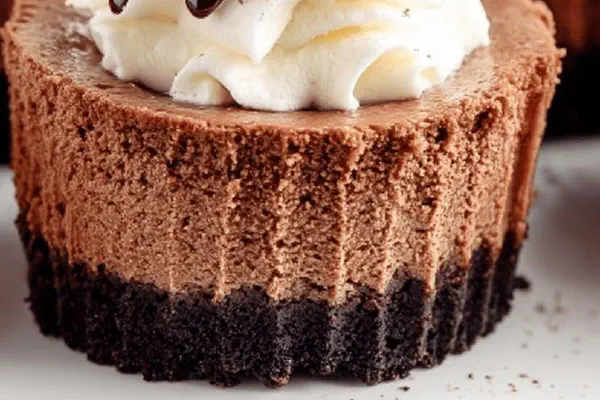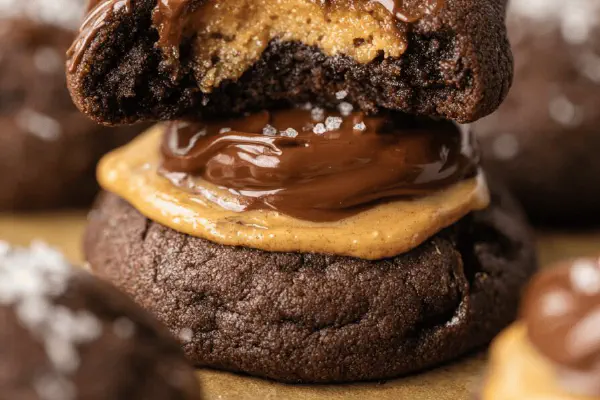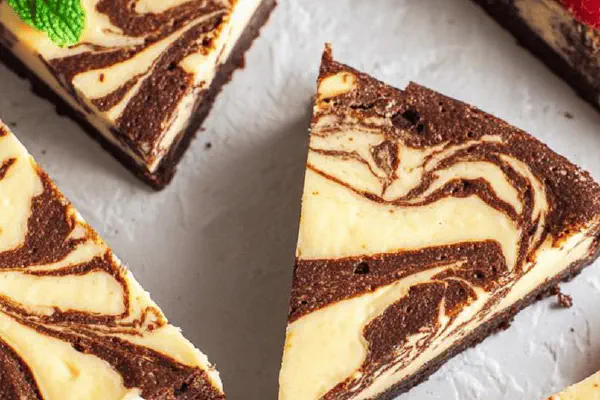Kahlua Chocolate Cheesecakes

By Emma
Certified Culinary Professional
Ingredients
- 1 ½ cups Oreo cookies (crushed to fine crumbs in a food processor)
- 6 tablespoons unsalted butter (melted, can swap with coconut oil for dairy-free)
- 16 ounces cream cheese (softened at room temp; avoid cold lumps)
- ¾ cup sugar
- 2 tablespoons unsweetened cocoa powder (prefer Dutch-processed for richness)
- 1 teaspoon pure vanilla extract
- 6 ounces bittersweet chocolate chips (melted and cooled slightly; swap with dark chocolate bar)
- 2 tablespoons all-purpose flour (lightly sifted to avoid clumps)
- ½ cup sour cream (full-fat or Greek yogurt works as a tangy substitute)
- ⅓ cup Kahlua (coffee liqueur, can replace with strong brewed espresso for non-alcoholic)
- 3 large eggs (room temperature to avoid curdling)
- 1 cup heavy cream (for whipping, chilled well)
About the ingredients
Method
- Set oven to 320 degrees Fahrenheit. Line 24 muffin tin cups with paper liners—don’t skip liners or cleanup’s brutal.
- Nuke chocolate chips in 25-30 second bursts stirring each time. Stop once silky. Let it cool to avoid scrambling eggs later.
- Crush Oreos fine, no big chunks. Toss in melted butter and pulse 4-5 times until crumbs stick together but remain airy.
- Press about a tablespoon of crumb mix firmly into each liner. Use bottom of glass or mallet. Should hold shape snugly.
- In a big bowl, beat cream cheese smooth and cloud-like. Patience here; cold or underbeaten cheesecakes crack. Beat till no lumps.
- Add sugar, cocoa, vanilla. Scrape sides. Beat again. Mixture should be thick but spreadable, chocolate aroma will bloom now.
- Fold in cooled melted chocolate, flour, and sour cream. Mix gently to keep batter light but well combined.
- Pour in Kahlua. Stir carefully—avoid splashes because that’s mess you don’t want. Alcohol adds bite, but espresso works in pinch.
- Add eggs one by one, mixing by hand after each. Too much speed equals bubbles; bubbles equal cracks or holes after baking.
- Distribute batter evenly over crusts. Full to the rim but not overflowing—batter rises slightly and you want clean tops.
- Bake 18-22 minutes. Watch tops closely: edges firm up, center still slightly wobbly like gelatin when nudged.
- Cool at room temp for at least 25 minutes before fridge. Abrupt cooling will crack your surface. Then chill 1-2 hours or longer.
- Whip cream till stiff peaks form. Pipe swirls over cheesecakes. Dust with cocoa powder shortly before serving to avoid sogginess.
Cooking tips
Chef's notes
- 💡 Press Oreo crumbs firmly into liners. Too loose and crust falls apart, too tight and crust gets dense. Use a glass bottom or small mallet to pack evenly. Crust holds best with melted butter; coconut oil works but changes texture slightly. Crushing Oreos finely but not into powder keeps texture balance, small chunks add bite. Butter must be melted but not hot when mixed or crumbs get greasy and crust won’t set right.
- 💡 Beat cream cheese long enough. Cold lumps mean incomplete mix which leads to cracks. Room temp cream cheese beats smoother with less air bubbles. Overbeating can cause airy batter, leading to cracks and holes. Beat just enough to get creamy, soft cloud-like texture. Scrape bowl sides often for even mixing. Proper beating changes texture from sticky to light, a key sign before adding sugar and chocolate.
- 💡 Melt chocolate in short bursts—25-30 seconds max. Watch for glossy, silky surface but no bubbles or scorched spots. Let cool completely before folding in or eggs risk scrambling. Chocolate temperature affects batter texture drastically. Add gently folded flour and sour cream to lighten batter but don’t overmix to avoid deflating it. Batter appearance should look thick yet spreadable, faint shine signals ready for eggs.
- 💡 Eggs at room temperature absorb better, reducing grit and lumps. Add eggs one at a time, fold slowly by hand with soft strokes. Prevent bubbles to avoid cracks during baking. Rapid mixing traps air, leads to holes or craters in the cheesecake toppers. Use light motions, fold evenly but don’t overdo it. Batter should flow without streaks but keep some thickness. Beat care protects texture and bake surface integrity.
- 💡 Watch the bake closely around 18-22 minutes. Edges firm while center remains wobbly like jelly. Not runny but a gentle soft jiggle. Don’t rely on timer alone, look visual cues. Pull early if edges overbrown or center seizes; pull late and cracks develop. Cooling starts on countertop to prevent collapse, fridge chill follows to set flavors fully. Cracks often mean baked too hot or chilled too fast. Whip cream till stiff peaks, pipe last minute. Cocoa powder dusting avoids soggy topping.
Common questions
Why does my crust crumble?
Press crumbs too loose. Butter temp matters. Melted but not hot is key. Use enough pressure with glass bottom or mallet. Coconut oil changes crumb texture slightly—denser, less buttery hold. Check crumb size—fine but not dust. If it falls apart, bind better then chill longer before adding filling.
Can I substitute Kahlua?
Yes, strong espresso works well, minus alcohol’s effect on set. Alcohol impacts firmness; less or none make batter softer, bake time changes. Other coffee liqueurs too but watch sweetness level. Non-dairy or decaf espresso options available, but flavor won’t be same depth. Adjust sugar slightly if swapping out liqueur for brewed coffee.
Cheesecakes cracked after baking; fix?
Cracks mean overbeating or oven temp too high. Underbeaten cream cheese traps lumps causing uneven bake. Don’t mix fast, incorporate eggs slowly. Bake temp lower than usual for cheesecakes here—320°F. Chill slow on countertop before fridge to avoid sudden temp shock. If cracks appear, cover with thick ganache or fruit compote to mask.
Best way to store leftovers?
Refrigerate in airtight container, lasts 3-4 days. Freeze wrapped tightly, best under 1 month to preserve texture. Thaw slowly in fridge overnight. If frozen too long or thawed at room temp, texture suffers; crumb base soggy or batter drying out. For fridge storage, cover cream topping separately if possible to avoid moisture absorption.



